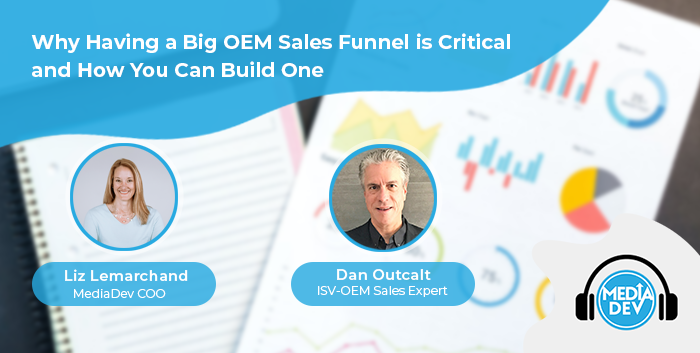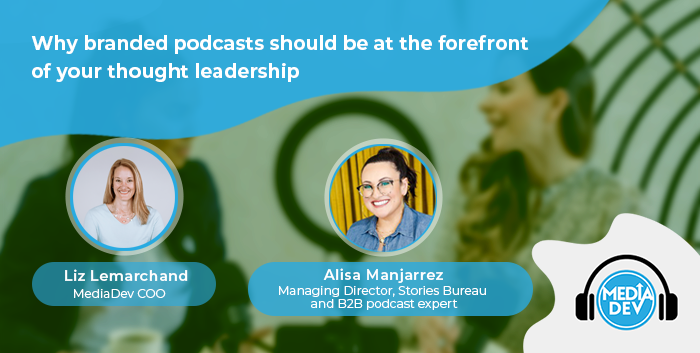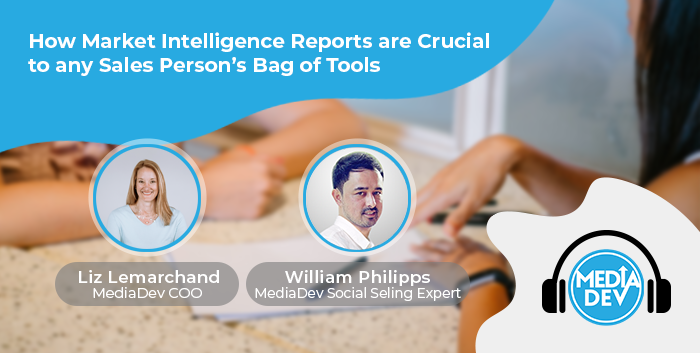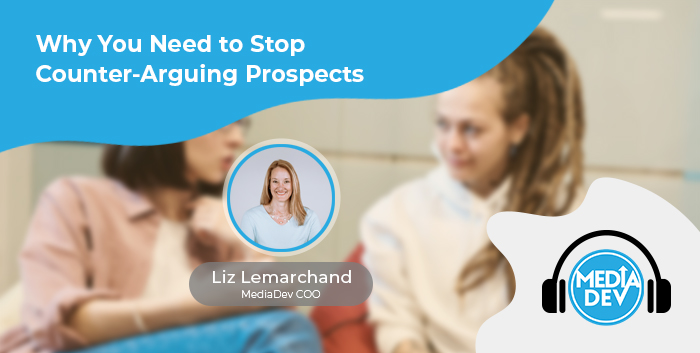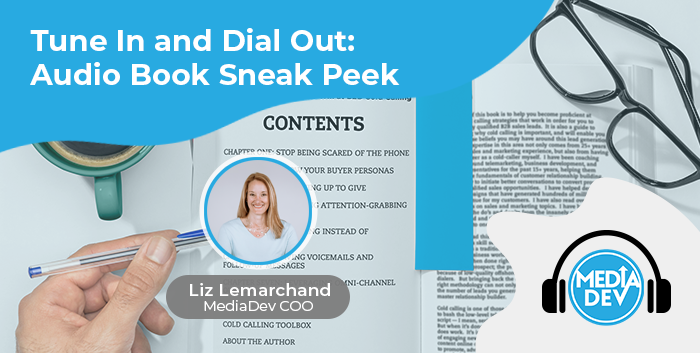Listen to the episode on Apple Podcast, Google Podcasts, Spotify, Breaker, Pocket casts, RadioPublic, or Anchor.
SHOW NOTES
What are some things that are absolutely necessary to have when launching a new lead generation camp? [01:31]
What should clients keep in mind when they kick off a program with a new vendor? [05:00]
What are some red flags that you need to watch out for when running a lead generation campaign? [08:31]
How is having feedback from our client sales teams fundamental to ensure success? [10:25]
What does a campaign setup process involve? [12:28]
Why continual coaching is important for telesales agents? [14:58]
OEM versus end-user campaigns [19:39]
Other things you can do to make sure any lead generation campaign is a success [23:34]
If you’ve enjoyed this episode, please subscribe via Apple Podcast | Google Podcasts | Spotify | Anchor to automatically get the next ones!
Thanks for Listening Today!
Please share it with someone you believe will benefit from listening to it. Use the share buttons below! They’ll thank you for it.
TRANSCRIPT
Liz Lemarchand: How is it that innovative software solutions have the ability to change the world yet they don’t sell themselves? How is it that I know my target market but I’m not able to generate enough sales opportunities? How do I even get started to create visibility for my brand when I’m not an expert? In marketing, that is the question and this podcast will give you the answer. Welcome to SMplified Software Marketing Made Simple.
OK, we should be live now. Hi everyone, this is Liz from MediaDev and today I am joined by Shai Schneiderman. How are you today?
Shai Schneiderman: Good, thank you.
Liz Lemarchand: Good, so for those of you that don’t know Shai, I always introduce Shai as my right arm. Although I don’t think that’s the greatest job title, I think maybe everything manager would be a better job title for Shai because he is always helping in the back office doing a little bit of everything, hoping to train agents onboarding with new clients, you know, getting scripts prepared, training, coaching, monitoring and really ensuring that the lead generation campaigns that we run our success. So that’s today’s topic, in fact, best practices for making any lead generation campaign a success. So, I’m excited to have Shai here today to talk about his vast experience in this domain, so I’m just going to dive right into the questions now.
So, Shai from your experience, what are some things that are absolutely necessary to have when launching a new lead generation campaign?
Shai Schneiderman: OK, so first of all, I think that, you know, both right arm and manager of everything is kind of a bad job title. Yeah, but yeah, yeah no.
So, before we start a campaign, I mean, I think some of the things that we have to have is first a good segmentation of the market and that’s probably coming from good data. And when we talk about data, we know how problematic it is to have personal data stored, but we do need to understand the target, first of all, we get the details from the client, right? We know what kind of companies they aim for because we do B2B campaigns. So, what size they should be? What revenue? Any other criterion? Specification? And then we need to understand, you know the markets that we are looking at? How are they constructed? How many companies do we have in target or at least approximately? And what do we know about them? So, if we talk about ISVs, then what do we know about those ISVs? What do we know about their offering, their vertical, the horizontals, the solutions they provide? Uhm, just basically to get a little bit of an idea how much of this market can we capture statistically, how many leads can we really generate, and I mean, I think this is probably the best starting point.
I think also with the client, after understanding the value proposition, after understanding everything that they want to do, maybe we should define the best cross-channel strategy. So, I mean, are we going to approach companies and people by phone? Are we going to do it for social media? Are we combining the methods? How do we combine the methods? When are we combining the methods? You know when method really makes sense and I think different markets different regions based on our experience, right? I mean they differ and different strategies apply, but the combination of I think understanding the market, really understanding the value proposition from the client and having people that really understand the topic and really close to the IT world to the software world that can deliver on this value proposition, of course, that’s priceless and integral part of the process. But the market segmentation, the ability of the agents to deliver the value proposition and defining the right strategy based on the different channels, it’s probably the right pillars to make the campaign a success. It’s all for the purpose, I think, of touching the market as quickly as possible because we want to start working for a client and we want to understand how many companies and how many relevant people and organizations are out there. How much do we know about them? How many of them can we reach out to quickly, to really understand? Who has some kind of an opportunity? Who has a space to implement a certain solution and just take it from there. So, I think, yeah, that that would probably be the ideal start, so yeah.
Liz Lemarchand: And what should clients keep in mind when they kick off a program with a new vendor?
Shai Schneiderman: I think clients would like to know, just my opinion, that vendors are really going to adjust based on their needs, the campaigns that we do. So, were very special. We’re uniquely focused on the IT space and software. And I think that’s very different from, let’s say, promoting coffee machines, because there’s like endless amount of people that like to drink coffee. But if you talk about a certain payment solution, or you talk about a certain database technology, you have to be a lot more knowledgeable. And there’s a lot less people and organization in certain regions that the value proposition is going to touch them. So, I think that clients should understand that the other vendor really knows the value proposition really close to the active world and can easily adjust because, you know, we we’ve seen in so many campaigns that we start something we think we have the right method. We think that we have the right strategy. We think that a certain value proposition and the delivery method is going to work and we dive into the campaign. We talked to people we talked to decision makers in some of the biggest organizations, and we learn something different. We learn that the different delivery method, uh, it’s going to work. We learn that maybe they don’t have needs where we thought they have, but the business needs lie elsewhere and you just have to quickly be able to inform the client that hey, we discovered something different that something different is going to work and somehow turn the whole methodology around, and I think that if you can’t do it quickly enough, it’s probably going to turn into a big problem, so adjustability, the ability to really understand a very techie, valuable position, I think they’re super important and I think that with some vendors I sometimes I notice that it’s very easy to get lost in all kinds of sales metrics, but it doesn’t necessarily give clients what they want.
I mean, there’s a lot of metrics that you can fall into with marketing, right? I mean how many people open them and how many people clicked on the email? How many people express these and that and keywords? But at the end of the day, clients mostly want to sell, and selling solutions, selling software, we have to get the right person engaged and we have to know that there’s a certain business need or there’s a pain point that we can leverage that our clients can leverage and build something over. Yeah, and that’s mostly going to come from a very meaningful, substantial human interaction, you know, ancient toe to toe prospect interaction.
So I think that in order to make sure that you really get what you want, that you really get meaningful results, not just an abundance of sales metrics, you need to have a vendor that can adjust you really quickly and that, really, at times, are very complicated and techie value proposition.
Liz Lemarchand: Completely agree with that. So, what are some red flags that you need to watch out for when running a lead generation campaign?
Shai Schneiderman: Well, there’s many like I said, sometimes we think that we know how to deliver the value proposition and we engage with the technical decision-makers or business decision-makers and we realize that we were wrong, like we should probably mention things differently or you know, change pitch. And that’s something that we can flag kind of early. I think that sometimes we realized that the expectation doesn’t really fit a timeline, and that’s become a little bit popular now with the COVID-19 with a lot of people working from home.
We often speak to decision-makers and we realized that even though there was a lot of interest in a certain solution, let’s say they didn’t have the budget, the timing was awful, but they were really willing to stay in touch. They were willing to review materials, they were happy to probably being with the client until the uncertainty is over and then see when they can launch a project. So sometimes the numbers don’t really fit the timeline, but I think if we can explain that, and of course, if we can explain the reasons, there’s still a lot of value. So, adjusting expectations, I think, to the timing, and sometimes I think that we notice that the content that we’re using is maybe not as engaging as we thought, and I think that’s something that if we tell the client, we usually or either we create the conduit ourselves, you know, we can solve. So, I think these are some of them, you know, more common red flags.
Liz Lemarchand: How is having feedback from our client sales teams fundamental to ensure success?
Shai Schneiderman: Very much so. I mean, ironically, I think that, if we compare two clients, one is really engaging and has direct communication with us. And sometimes even the agents and we have frequent training calls and they follow up in 24-48 hours after the lead is submitted and we have clients like that and we have had clients that didn’t give us feedback for weeks and sometimes more.
And although we are 100% sure that the lead quality is the same, the outcome is completely different. You know it’s just I think that this business is essentially is made of people, and I think that when we have our clients and their sales people really in touch with the agents, the people that are making the conversations that can explain to them what happened, why it happened like that, they can really, really understand what our clients are looking for, what they want. You know is their focus, and then the whole process becomes so much easier and we’ve seen the same quality of leads sometimes get immediate follow up immediate feedback very much in touch with what clients ask for. And the same quantity of leads or the same methodology with a client that is not doing a very frequent follow up, it’s just different worlds really something completely different so yeah, it’s just a huge factor to make a campaign success.
Liz Lemarchand: Yeah, I agree with that. I think that when we work in a silo and we’re not able to exchange regularly, it makes it hard on both sides so yeah, I definitely think that it’s a good idea to have frequent contact and interaction.
Can you describe what the campaign setup process involved?
Shai Schneiderman: So usually for us of course, first we have to understand from the client what is it that you’re looking for. So, the value proposition, I know a lot of clients think that they don’t have competition or that the competition is not as good and it’s often not correct and we really, I think in my opinion, everything that we can learn about any edge that they have in the market, anything that differentiates them from the competition is at the end of the day, it’s going to be a huge help because we have to study our clients. We have to study the solutions, the product, we have to know what we’re talking about. So, after getting this information and after understanding the target audience, the region and any job title in the organization. That might be a good target for us. Then we start this process of market research and data preparation. So, we want to understand, like I said, how many organizations do we have in that specific market that we can target? What do we know about these organizations? Who is the better target? Who is the least better target and then, of course, training the agents, making sure that they’re up to speed with everything, that they understand the value proposition, thinking about all the different delivery methods, all the different pitches and all the ways we can approach different people in the organization, mentioning the edge, the things that are more relevant to them. Of course, if we do social media then setting that up. I think that’s pretty much how it goes.
Liz Lemarchand: Yeah, and then like you said earlier, that kind of loop where we deliver leads. The clients give feedback and we continue to improve the process along the way. And I do agree with you when you say, you know, we have to do kind of cross-channel marketing and, you know, preparing those email pitches and preparing you know pitches for the phone or pitches on, you know, In mail messages on LinkedIn, for example, like all those different aspects are important to get down, kind of as we start, but I do agree with what you said before, which is that we also need to be able to pivot and be flexible and adjust if things don’t go exactly, you know, how we had planned initially in that setup phase.
So, why do you feel continual coaching is important for our tele sales agents?
Shai Schneiderman: So, I think this is really connected to adjustability. I mean, I think, that we know this is sometimes really not scientific. We know that especially when we speak to decision-makers over the phone, a couple of different words here and there can make a world of a difference, right? So, it’s the feeling of confidence that you know that people know what they’re talking about can really make the difference between a conversation that is developing into a lead, that is developing on something that can be followed up on and into a sale, and something that just goes nowhere right together because the prospect doesn’t want to talk to you, so I really think I’m a purist in that regard. I really think we should know as much as possible. Of course, we will never be as technical as some of those IT managers that we talked to. We are not going to call a multibillion-dollar company, speak to some of their most technical people, and pretend to be more technical than them. It’s never going to.
But we should know what we’re talking about, and I think that the level of conversation and the level of an agent that really knows the material, again, it’s priceless, and sometimes it’s hard to quantify just how many opportunities are lost because the other side feels that maybe the person that speaks to him is not so confident, he really is not sure what he’s talking about, right? So, I think that the coaching aspect, you know it’s never-ending. But also, I think that I realized, with time, we work with clients that have data analytics solutions and backup and recovery solutions and database technology and ERP’s, UM workforce management solutions and I think that, there are certain topics in, like, analytics and AI that if you understand them, that they just manifest themselves in different aspects of business. But the issue is sometimes the same, like, lack of insight, right? Lack of insight is an issue that can appear, you know, for people that deal with operations as a whole, marketing, sales and this, the solutions of the applications that answer those business challenges are different, but the topics are kind of the same, right? IIt’s like the same issue that is manifesting in many areas of business, and I think that agents that can make those connections right that maybe they can speak to a sales director and here’s something lack of insight, lack of ability to aggregate data and the more that they know you know it will start to bust them that it’s probably affecting a lot of other people in the business in many other directions and then they can really connect to those people and really build on that conversation.
So yeah, it’s super important and something that we try to do all the time, right? I mean kind of coaching is it’s never-ending. It never feels like it’s enough. And you know, ’cause It’s probably isn’t. I mean, it’s just you can always learn something new.
Liz Lemarchand: Yeah, and it’s true too. I mean, there are always going to be the instances, as well, where no matter how good we are, there’s still going to be other, you know, prospects at the other end, so they’re just not in a good mood that day, so you know. I mean, I do think there is that aspect too. You know you like you said before, it’s human to human interaction. So, there is also that element. But it’s also about persistence, and I do think that coaching you know is just part of the persistence aspect of trying to perfect and at the same time, there’s always a variable which is that every company is different and every decision maker is different and every you know person that we talked to is going to be different, so there’s also that aspect to deal with too which, personally is why I think the job is so interesting because it changes all the time, you know, you don’t have the ability to get bored, no matter what, no matter what.
Shai Schneiderman: Yeah, it’s been so frustrating because it’s never something that works once you know you, sometimes your muscles work again because a different market or different value proposition. So yeah, interesting and frustrating.
Liz Lemarchand: Challenging, challenging for sure.
So as most of the people listening probably know, we do focus a lot on OEM types of campaigns, so OEM versus end-user campaigns. Which type do you prefer and why?
Shai Schneiderman: I think the OEM campaigns. I think that at the beginning when we started to do OEM, uh, I think it felt like something a little bit more intimidating because we mostly did end0user campaigns. But now I think it’s probably a little bit nicer because I feel that, you know, we time and people are just not they don’t want to be sold anything right? I mean you call local people and the moment that you feel you’re trying to be a little bit salesy, you want them to spend money, doing anything I think it’s just an instinct of ours, so you just get an immediate pushback.
And with the OEM campaigns it’s not about benefiting the individual so much as it’s about benefiting a product or service to the company is making. So, I think in that way they tend to listen a lot more and when it’s coming to total spending and you know it’s coming to progressing, I think they feel OK, so this is something that is actually supposed to improve the value proposition as a whole or something that can benefit our clients, something that can benefit the end-user at the end of the day. So OK, let’s talk now regardless of the money, you know it’s more like that, and with the end-user campaign I, I think that again with time we see that people mentality is like OK, you want to send me something I’m just not interested. So yeah, for me, the only campaigns a little bit more interesting, a little bit more sometimes nicer to run, and sometimes we do both.
I mean, we have clients that we run OEM campaigns and end-user campaigns at the same time, which is also kind of an ideal scenario because you know, would you call a company and sometimes they have solutions that they develop on their own, but they also have business needs that you know we can jump into end-user conversation, which is also great.
Liz Lemarchand: Yeah, I agree, I think that’s the best is being really open about the deliverable and being able to have kind of a plethora of choice because we do come across so many different types of opportunities, you know, working with software vendors we’ve even come across, you know, reseller opportunities when we weren’t expecting to have those or end user leads like you said when we were perhaps going after, you know, an embedded ISV to ISV partnership, you know?
So, it is good to have an open mind. It’s true that sometimes, though our clients have budgets that are set aside for specific actions, so it’s not always possible. But I think when it is, that’s really the best bang for your buck is being open to any kind of conversation that we can have and then just seeing where it takes us right?
Shai Schneiderman:And it’s also coming to feedback because with clients that really stay in touch with us and you know we can discuss these scenarios. I mean we have we have clients that, let’s say allocated budget for OEM and we came across end user leads and they ended up being, uh, you know, big deals developing right? I mean, they had a lot of values, so a client that we really don’t have such a frequent feedback and we can’t discuss that. Basically, the opportunity is lost and the client that you know we can explain the situation. We can think together what to do sometimes they rotate those end user leads, let’s say to the relevant department and they can follow up. So yeah, yeah, it’s ideal when it’s coming together as a whole.
Liz Lemarchand: So absolutely yeah. And that goes back to just to, you know, our vision of holistic marketing and you know that comes before like you said, you know with cross-channel omnichannel always-on types of activities you know instead of working in a silo like we said before so good.
Is there anything else that you’d like to add about what we can do to make sure any lead generation campaign is a success.
Shai Schneiderman: I think, I mean we covered the uh, most of it. I think that I’m sometimes myself just surprised as to how much I mean, how much work we have now.
Liz Lemarchand: Everybody needs leads
Shai Schneiderman: Yeah yeah yeah, no, it’s insane you know the big tech companies they didn’t take a heat uh, like other markets and the tech industry remained pretty much active. So, it’s kind of crazy, but yeah, no, it’s just really amazing because you know, five years ago I mean what did we use to discuss?
We used to discuss antivirus solutions and things that today seems like ancient history and today, why do we discuss AI algorithms and machine learning and serverless infrastructure so it’s so interesting to learn new things and when we get a client that has something that we might find a little bit new.
Liz Lemarchand: Watching an IRT.
Shai Schneiderman: that we also have to learn, it’s exciting and I mean, who knows what we’re going to discuss in 10 years like quantum computing or something crazy? I mean, it’s really the possibilities are endless.
Liz Lemarchand: Super thank you so much for your time today. Shai. And for those of you listening for other great resources including other podcasts, check out our resource library at mediadev.com. and we’ll see you back soon for another episode.
Thanks again.
Shai Schneiderman: Thanks, thank you.
Liz Lemarchand: You just listen to simplified brought to you by media Dev. If you have software marketing questions or need help marketing your software solution, reach out to us at contact at mediadev.com and check out other amazing assets for you on our resource library at mediadev.com.



